CRM Process
CRM Process
What is CRM Process?
CRM process involves the activities and strategies that companies use to manage their interaction with current and potential customers...Successfully collecting information about your customers allows you to understand them more.In turn,you can improve your products and services based on their demands.
「CRM 流程涉及公司用来管理与当前和潜在客户的互动的活动和策略...成功收集有关客户的信息可以让您更好地了解他们。反过来,您可以根据他们的需求改进您的产品和服务。」

CRM Cycle
CRM is a continuous process of optimising interactions with the customer and seeking new opportunities to increase sales.
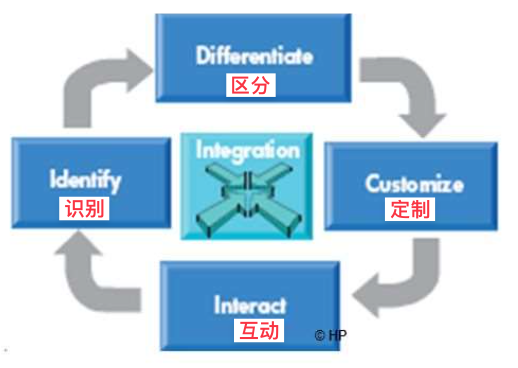
This CRM cycle consists of 4 stages
- Identify customer
- Analyse and differentiate customer behaviour to identify propensity to buy specific products.
- Customise customer plan to optimise revenue
- Customise customer "touch points" [interaction] to optimise revenue.
CRM Workflow
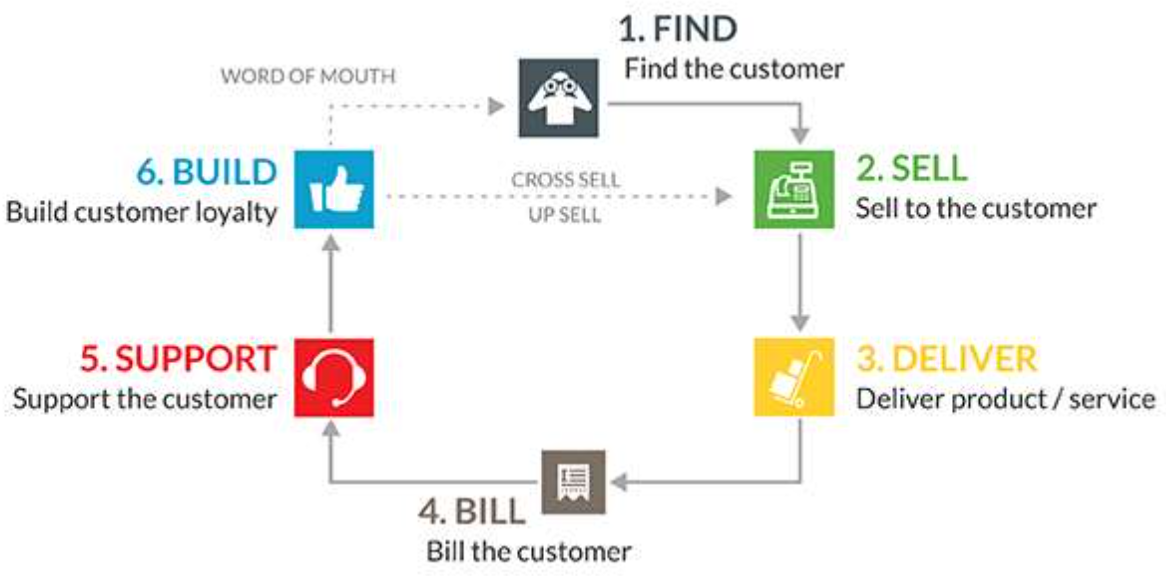
Framework/Models
客户关系管理是一种获取、保留和与选择性客户合作的综合策略和过程,为公司和客户创造卓越的价值。正如上述定义所隐含的那样,CRM 的目的是提高营销效率。
任何客户关系管理的实施都需要考虑四个核心组成部分:
- 技术(应用程序和基础设施)
- 战略(业务目标和目的)
- 流程(程序和业务规则)
- 人员(组织结构、技能和激励措施)
对不同的人来说意味着不同的事情
- 可能是 salesforce 联系软件,例如 salesforce.com 出售的软件
- 可能是电话呼叫中心,用于联系人管理
- 可能是忠诚度计划
CRM framework is to define the activities required to successfully create, plan and execute a CRM program (process).
目前已开发出各种全面的客户关系管理 CRM 模型。
Five popular CRM models
- IDIC Model (Identifying, Differentiating, Interacting, Customizing)
- QCI Model (Quality Competitiveness Index)
- CRM Value Chain Model
- The Payne’s Five Forces Model
- Gartner ‘s Competency Model
Grandma’s Wisdom
Proactive customer outreach is at the heart of Customer Success 「积极主动的客户拓展是客户成功的核心」
The IDIC model of CRM
这个模型强调了公司要想实现一对一的营销,就必须通过以下四个步骤或方面来理解和交流与每个客户的关系:
- 识别(Identification)
- 这一阶段的目标是识别你的客户,并了解他们的个体差异。这通常涉及到收集和分析数据来识别消费者的行为、购买历史和购买潜力。
- 公司不仅要知道谁是他们的客户,还要理解客户的需求和愿望。
- 区分(Differentiation)
- 这一阶段着重于区分你的客户,以了解他们的不同需求和价值。在这里,客户通常被划分为不同的细分市场或群体,基于他们的行为、需求或价值。
- 通过区分,公司可以确定哪些客户具有更高的客户生命周期价值(CLV)并据此优化资源分配。
- 互动(Interaction)
- 在这一阶段,公司与客户进行互动,与他们沟通并积极响应他们的需求和反馈。
- 互动可以帮助公司了解客户的需求和期望,进一步加深对客户的理解,并强化客户关系。
- 定制(Customization)
- 基于前三个阶段的信息和理解,这一阶段要求公司定制其产品、服务和沟通,以满足每个客户群体的具体需求。
- 这意味着利用收集到的信息来个性化产品、服务和市场营销策略,使之尽可能符合每个客户的个别需求和期望。
QCI Model
这个流程描述了公司为获取和留住客户而需要开展的一系列活动;该模型的特点是人们执行流程并使用技术来协助这些活动。
The CRM Value Chain
该模型分为 5 个主要阶段和 4 个辅助条件,最终目标是提高客户盈利能力。
阶段:客户组合分析、客户亲密度、网络开发、价值主张开发、管理客户生命周期
"The CRM Value Chain" 是一个由Francis Buttle在2001年提出的模型,用于帮助组织更有效地发展和实施客户关系管理(CRM)战略和实践。这个模型关注如何从内部和外部的角度来增强公司与客户之间的关系,从而创造更多的价值。CRM价值链分为5个主要的、相互关联的阶段,这些阶段有助于组织在构建和维护客户关系时实现最大的价值。
以下是CRM价值链的五个关键阶段:
- 客户选择(Customer Selection) 这一阶段关注确定和选择最有价值的客户或客户群体。它涉及到对潜在客户群体的分析和识别,以便组织能够专注于那些最有可能带来最大回报的客户。
- 客户获取(Customer Acquisition) 在这个阶段,公司运用不同的策略和技术来吸引和获取新客户。这可以包括利用营销活动、广告、促销和其他各种方法来吸引潜在客户并促使他们采取购买行为。
- 客户保留(Customer Retention) 这一阶段的重点在于保持现有客户的忠诚度和满意度。通过提供卓越的客户服务、高质量的产品或服务、定期的沟通和奖励计划,组织可以增强与现有客户的关系。
- 客户扩展(Customer Extension) 这个阶段涉及到增加与现有客户的交易。方法可以包括交叉销售(cross-selling)、再销售(up-selling)或劝诱现有客户购买与他们先前购买过的产品或服务相关的其他产品或服务。
- 客户终止(Customer Termination) 最后,有些情况下,组织可能发现某些客户关系不再是盈利的或者对组织没有价值,此时它们可能选择结束这些关系。在某些情况下,通过优雅且尊重的方式终止不再有价值的客户关系,以便组织可以将资源重新分配到更有价值的客户身上,这同样是非常重要的。
这个模型强调了在整个客户生命周期中通过不同阶段的管理来实现客户价值最大化的重要性。
Payne's CRM Model
Payne的CRM模型关注于如何通过管理与客户的关系来创造并增强客户价值。这个模型旨在帮助组织更好地理解和利用客户信息,优化客户互动和提高客户满意度和忠诚度,从而获得长期盈利。这个模型侧重于客户生命周期的各个阶段,强调了需建立和维护长期、有价值的客户关系。
Five core processes
- Strategy development
- Value creation
- Multi-channel integration
- Performance assessment
- Information management
Gartner's Competency Model
- CRM Vision: Leadership,Social Worth,Value Proposition
- CRM Strategy: Objectives, Segments, Effective Interaction
- Valued Customer Experience
- Organizational Collaboration
- CRM Processes: Customer Life Cycle,Knowledge Management
- CRM Information: Data,Analysis,One View Across Channels
- CRM Technology: Applications,Architecture,Infrastructure
- CRM Metrics: Cost to Serve,Satisfaction,Loyalty,Social Costs
CRM Platform
A Customer Relationship Management Platform (CRM Platform) refers to the technology a company employs to manage interactions with a customer,capturing key information generated during those engagements.
A CRM platform lets you manage the inquiry across channels without losing track,and gives sales,service,and marketing a single view of the customer to inform their activities.
Platform vs. Framework
What is difference between a platform and a framework?
- A platform is a much more comprehensive, usually a multipurpose product and may actually host a framework in itself along with other tools.
- A framework is defined as "an abstraction in which software providing generic functionality can be selectively changed by additional user-written code,thus providing application-specific software. A software framework provides a standard way to build and deploy applications."
- When you use a framework, you may need to form your own “platform-like” environment by combining various tools for various needs; whereas in a platform, these needs can be met from a single point and in a tightly integrated manner, increasing productivity and making it more suitable for enterprises.
Types of CRM
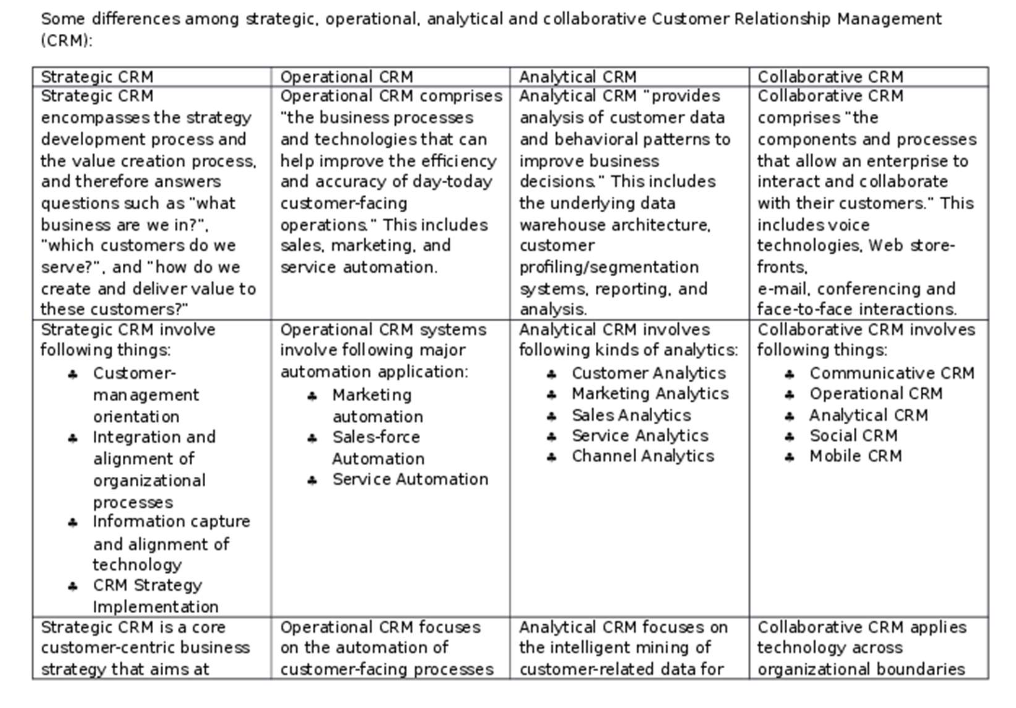
Strategic CRM
- Strategic CRM: 战略性客户关系管理是一项以客户为中心的核心业务战略,旨在赢得并留住有利可图的客户。
- 为什么要以客户为中心? => 客户至上的经营策略
- Product-oriented 「产品导向」: 企业相信客户选择的产品具有最好的质量、性能、设计或功能。
- Production oriented:「生产导向」:企业认为,顾客会选择低价产品。
- Sales-oriented businesses: 假定只要在广告、销售、公共关系(PR)和促销方面投入足够的资金,就能说服顾客购买。
- A customer or market-oriented: 公司拥有一套将客户放在第一位的信念。它收集、传播和使用客户和竞争信息,为客户制定更好的价值主张。以客户为中心「customer-centric」的企业是一个不断学习的企业,它不断适应客户的要求和竞争条件。
Operational CRM
Operational CRM focuses on the automation of customer-facing processes such as selling, marketing and customer service.
- Marketing automation
- Sales force automation
- Service automation
Analytical CRM
Analytical CRM focuses on the intelligent mining of customer-related data for strategic or tactical purposes.
Sources of Customer-related Data
- Internal sources: 销售数据(购买历史记录)、财务数据(付款历史记录、信用评分)、营销数据(活动响应、忠诚度计划数据)和服务数据。
- External sources: 例如,商业情报机构提供的地理人口和生活方式数据。
Collaborative CRM
Collaborative CRM applies technology across organizational boundaries with a view to optimizing company, partner and customer value.
- 企业战略和战术调整,以更有利地识别、吸引、保留和开发客户
- E.g. EDI, conferencing, email, web-forum...
- PRM
- Example: Google apps platform/ Microsoft 365
CRM Understanding
CRM is the core business strategy that integrates internal processes and functions, and external networks,to create and deliver value to targeted customers at a profit.It is grounded on high quality customer-related data and enabled by information technology.
Misunderstandings about CRM:
- CRM is database marketing
- CRM is a marketing process
- CRM is an IT issue
- CRM is about loyalty schemes
- CRM can be implemented by any company
CRM is concerned with the following issues:
- Facilitated by technology: Marketing, sales-force and service automation
- A kind of business Strategy
- Capture, store, integrate, analyze, report customer data
- Enhance
- Customer interaction
- Profitability
- Customer value
- Customer Satisfaction
Choosing the Right CRM
找到完美的 CRM 解决方案并非易事。虽然一些 CRM 专注于特定领域(操作、分析和协作),但其他 CRM 则拥有更强大的功能,涵盖多种类型的 CRM。了解您的需求是最终选择合适平台的关键。研究 CRM 软件时,请使用下面的列表作为指南。
- 建立需求清单
- 了解您的行业
- 比较产品
- 问问题
- 使用 RFP 流程
Conclusion: BI in CRM => Data-driven CRM
Origins of BI in CRM
- CRM 是从一系列独立技术发展而来的,包括呼叫中心、销售人员自动化系统和客户信息文件 (CIF),其中一些技术可以追溯到 20 世纪 70 年代或更早。
- 在 20 世纪 80 年代末,一些组织试图整合其中一些不同的技术。
- 客户开始被所有面向客户的部门视为一个整体,从而产生了 "单一客户视角 "的概念。
Data-driven CRM
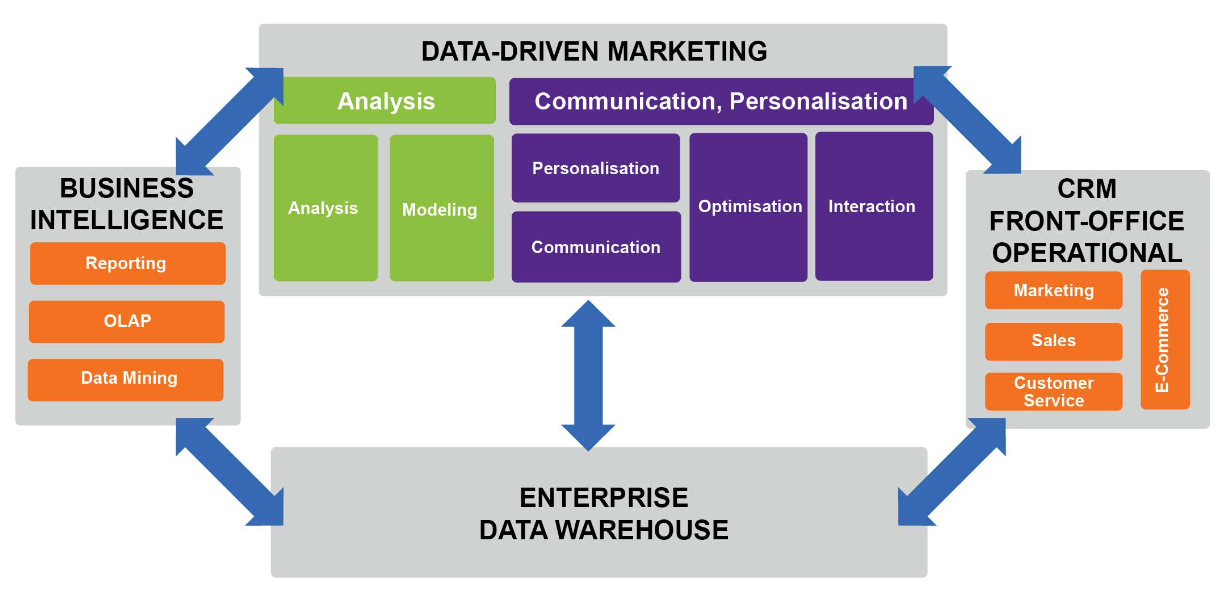
CRM related data:
- Customer related data => Single view
- Relationship data => Measurement
- Management data => Operation
Customer-related Data
- Data types/sources: diversity / multiple channels
- Decision support: single view of the customer in the front office
- Customer expectation: consistent dialogue
- Challenge: heterogeneous「异构的」 customer related data => single view
Relationship Management
A relationship is composed of a series of interactive episodes between parties over time.
What is interactive episodes「互动情节」?
- Time bound「有时间限制」
- Nameable「可命名的」
- Interaction「相互作用」
Episodes are composed of a series of interactions. Interaction consists of action, and response to that action.
提示
Relationships are viewed as social constructs:
- Social construct: A relationship exists if people believe that a relationship exists and they act accordingly.
- Uni-lateral or reciprocal 「单边或互惠」: Either one, or both, parties may believe they are in a relationship.
Attributes of High Quality Relationships
Core attributes
- Trust
- Commitment「承诺」 <= Customer Value「客户价值」
Additional attributes
- Relationship satisfaction
- Mutual goals 「共同目标」
- Cooperative norms「合作规范」
The Importance of Customer Relationship
Why companies want relationships with customers?
- Because companies that manage their customer base in order to identify, satisfy and retain profitable customers enjoy better business results.
- Reduced customer churn (customer defection rate) creates
- A larger customer base
- Longer average customer tenure「保有期」
- Reduced marketing costs to replace defected customers
- Better understanding of customer requirements
- More cross-selling opportunities
Customers are potential income streams
A core CRM idea is that a customer should not be viewed as a set of independent transactions but as a life-time income stream.
Churn Rate & Retention Rate
Churn Rate 「流失率」 = Total No.of Customers Lost During Period / Total No.of Customers of Company at Beginning of Period
CUSTOMER RETENTION RATE「客户保留率」 = (期末客户数量 - 在此期间新客户的数量)/ 期初拥有的客户数量
Organizational Benefits from Managing Customer Retention
Organizational Benefits from Managing Customer Retention
- 降低营销成本: 更换流失客户所需的费用减少
- 更好的客户洞察
- 供应商能够更好地了解客户的要求和期望,客户也能够了解供应商可以为他们做什么。
- 因此,供应商能够更好地识别和满足客户需求,从而向保留的客户销售更多的产品和服务,从而实现盈利。
- 随着时间的推移,随着关系的加深,双方之间的信任和承诺可能会增加,来自客户的收入和利润流也会变得更有保障。
Customers and Their Values
The Customer Journey
- Suspect「怀疑」: Does the potential customer fit your target market profile?
- Prospect「前景」: The customer fits the target market profile and is being approached for the first time.
- First-time customer 「初次顾客」:The customer makes a first purchase.
- Repeat customer 「回头客」:The customer makes additional purchases.Your offer plays a minor role in the customer's portfolio.
- Majority customer「多数客户」:The customer selects your company as supplier of choice.You occupy a significant place in the customer's portfolio.
- Loyal customer「忠诚客户」:The customer is resistant to switching suppliers,and has a strong positive attitude to your company or offer.
- Advocate 「提倡」:The customer generates additional referral dollars through positive word-of-mouth.
Four Causes of Profit Margin Growth Over Time:
- Revenues grow over time, as customers buy more.
- Cost-to-serve is lower for existing customers,because both supplier and customer understand the other.
- Referrals are generated by existing,satisfied customers through their unpaid advocacy.
- Higher prices are paid by existing customers than new customers.
Customer Life-time Value
Life-time value (LVT) is the present day value of all net margins.
「生命周期价值是所有净利润的现值」
生命周期价值 (LTV) 是指从与客户、客户群或客户群的关系中获得的所有净利润的现值「the present day value」。
- 在计算 LTV 时,所有历史净利润率均按复利计算至当前值,所有未来净利润率均折现至当前值。
- 对 LTV 潜力的估计只着眼于未来,而忽略了过去。
- 如果考虑到服务客户的成本,从毛利率角度看似乎很有价值的客户,其利润很可能会降低。
客户的现值是以下各项之和
- 所有过去的净利润率复合到今天的价值,以及
- 所有未来净利润率折算成今天的价值
The potential value of a customer is all future net margins「未来净利润」 discounted to today's value
更多计算公式
客户终身价值(CUSTOMER LIFETIME VALUE (CLV)FORMULA ,CLV)计算公式
CUSTOMER LIFETIME VALUE = (Average Purchase Value - Average Purchase Frequency) x Average Customer Lifespan
- AVERAGE PURCHASE VALUE = Total Revenue / # of Purchases
- AVERAGE PURCHASE FREQUENCY = # of Purchases / Unique Customers
- AVERAGE CUSTOMER LIFESPAN 「客户平均寿命」= Customer Lifespans Total / # of Customers Used in Equation
估算 CLV 的一个简单方法是假设贡献率、保留率和贴现率为恒定且长期的值

Calculation of LVT


计算 LTV 需要什么?
洞察现有客户的未来购买行为
- 在接下来的 x 时间段内购买产品的概率
- 从这些产品中赚取的利润
- 客户管理的定期成本
另外,对于新客户
- 获客成本
- 未来净利润率的贴现率
Core Strategies to improve Cohort「群体」 Profitability
- 在合作初期提高客户保留率。这将产生更多的客户,从而在后期创造更高的利润。
- 通过以下方式增加每位客户的利润
- Reducing cost-to-serve
- Cross-selling or up-selling additional products and services
- 通过以下方式更好地获取客户
- 使用更具成本效益的招聘渠道
- 对潜在客户进行更好的资质审查。那些一开始就叛逃的客户或许一开始就不应该被招募。
Satisfaction-Profit Chain

- Customer satisfaction
- Understand customer requirements
- Meet customer expectations
- Deliver customer value
- Customer loyalty
- Attitudinal loyalt
- Behavioural loyalty
- Business performance
- Revenue growth「收入增长」
- Share of customer「客户份额」
- Customer tenure「客户保有期」
Customer Satisfaction
Customer satisfaction is the customer’s fulfilment response to a customer experience, or some part thereof.
Two dimensions of customer loyalty:
- Behavioural loyalty
- Is the customer active?
- What is our share of customer spend
- RFM variables
- Attitudinal loyalty
- Beliefs
- Commitment
- Preference
- Intention to buy
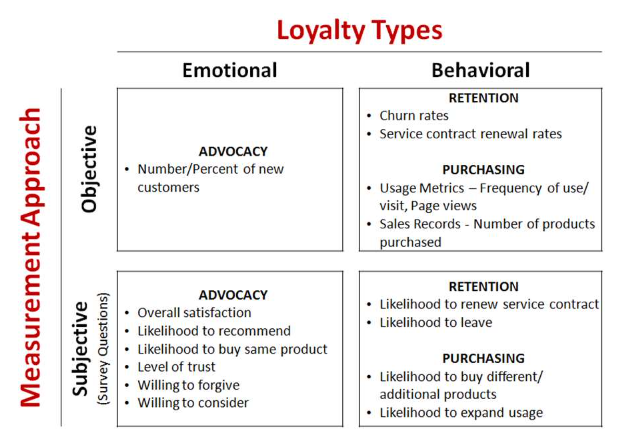
RFM measures Behavioural Loyalty
- Recency(最近一次购买):这个维度衡量的是客户最后一次交易或者购买的时间。一般来说,最近购买过的客户更可能再次购买。
- Frequency(购买频率):这个维度衡量的是客户购买的频率。频繁购买的客户更可能在未来继续购买。
- Monetary(购买金额):这个维度衡量的是客户购买的总金额。花费更多的客户可能对公司的产品或服务有更深的承诺,并且更有可能在未来继续购买。
RFM 分析可以帮助公司识别出最有价值的客户群体,以便更有效地定向营销和服务。例如,一个客户如果在 Recency,Frequency 和 Monetary 上都得分很高,那么这个客户就可能是一个非常有价值的客户。